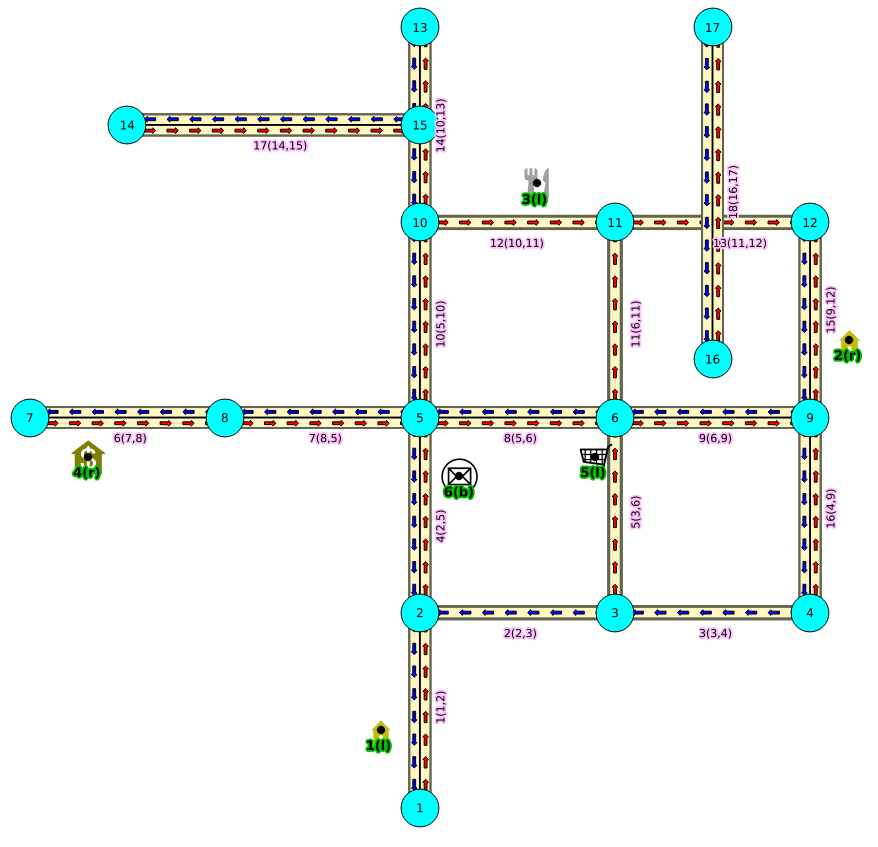PostGIS/pgRouting 最优路径规划 管网连通性分析
PostGIS/pgRouting管网连通性分析及最优路径规划
一、拓展安装
pgrouting依赖postgis,要先安装postgis
https://github.com/pgRouting/pgrouting/wikites-on-Download%2C-Installation-and-building-pgRouting
云主机
需要已经安装过postgresql与postgis可使用命令:
sudo apt install postgresql-9.3-pgrouting
window系统
安装地址:http://download.osgeo.org/postgis/windows/
二、创建扩展
使用前需要先在pg数据库创建扩展
--pgrouting依赖postgis
CREATE EXTENSION PostGIS
CREATE EXTENSION pgRouting
三、样例:
1、新建数据表edge_table
CREATE TABLE edge_table (
id BIGSERIAL,
dir character varying,
source BIGINT,
target BIGINT,
cost FLOAT,
reverse_cost FLOAT,
capacity BIGINT,
reverse_capacity BIGINT,
category_id INTEGER,
reverse_category_id INTEGER,
x1 FLOAT,
y1 FLOAT,
x2 FLOAT,
y2 FLOAT,
the_geom geometry
);
2、插入数据
INSERT INTO edge_table (
category_id, reverse_category_id,
cost, reverse_cost,
capacity, reverse_capacity,
x1, y1,
x2, y2) VALUES
(3, 1, 1, 1, 80, 130, 2, 0, 2, 1),
(3, 2, -1, 1, -1, 100, 2, 1, 3, 1),
(2, 1, -1, 1, -1, 130, 3, 1, 4, 1),
(2, 4, 1, 1, 100, 50, 2, 1, 2, 2),
(1, 4, 1, -1, 130, -1, 3, 1, 3, 2),
(4, 2, 1, 1, 50, 100, 0, 2, 1, 2),
(4, 1, 1, 1, 50, 130, 1, 2, 2, 2),
(2, 1, 1, 1, 100, 130, 2, 2, 3, 2),
(1, 3, 1, 1, 130, 80, 3, 2, 4, 2),
(1, 4, 1, 1, 130, 50, 2, 2, 2, 3),
(1, 2, 1, -1, 130, -1, 3, 2, 3, 3),
(2, 3, 1, -1, 100, -1, 2, 3, 3, 3),
(2, 4, 1, -1, 100, -1, 3, 3, 4, 3),
(3, 1, 1, 1, 80, 130, 2, 3, 2, 4),
(3, 4, 1, 1, 80, 50, 4, 2, 4, 3),
(3, 3, 1, 1, 80, 80, 4, 1, 4, 2),
(1, 2, 1, 1, 130, 100, 0.5, 3.5, 1.999999999999,3.5),
(4, 1, 1, 1, 50, 130, 3.5, 2.3, 3.5,4);
3、生成路径信息和路径通达性
根据cost和reverse_cost两个字段,生成the_geom(两点间地理信息/路径信息)和dir两点间路径通达性:
UPDATE edge_table SET the_geom = st_makeline(st_point(x1,y1),st_point(x2,y2)),
dir = CASE WHEN (cost>0 AND reverse_cost>0) THEN 'B' -- 双向通行
WHEN (cost>0 AND reverse_cost<0) THEN 'FT' -- 正向通行
WHEN (cost<0 AND reverse_cost>0) THEN 'TF' -- 反向通行
ELSE '' END; -- 其他情况不操作
4、创建拓扑
--只有构建拓扑之后,才能进行路径规划。0.001是拓扑容差,两个点的距离在这个距离内,就算重合为一点。这个距离使用st_length计算
SELECT pgr_createTopology('edge_table',0.001);

5、尝试进行查询获取最短路径
pgr_dijkstra函数可以获取最短路径
SELECT * FROM pgr_dijkstra(
'SELECT id, source, target, cost, reverse_cost FROM edge_table',
4, 8)
6、官方样例中还有更多的使用方式
pointsOfInterest 、restrictions、new_restrictions、customer等
官网提供的完整样例 https://docs.pgrouting.org/3.0/en/sampledata.html
四、pgr_dijkstra使用
pgr_dijkstra(edges_sql, start_vid, end_vid [, directed])--一对一
pgr_dijkstra(edges_sql, start_vid, end_vids [, directed])--一对多
pgr_dijkstra(edges_sql, start_vids, end_vid [, directed])--多对一
pgr_dijkstra(edges_sql, start_vids, end_vids [, directed])--多对多
pgr_dijkstra入参
| Parameter | 类型 | 默认值 | 描述 |
|---|---|---|---|
| edges_sql | TEXT |
内部 SQL 查询。 | |
| start_vid | BIGINT |
路径起始顶点的标识符。 | |
| start_vids | ARRAY[BIGINT] |
起始顶点的标识符数组。 | |
| end_vid | BIGINT |
路径结束顶点的标识符。 | |
| end_vids | ARRAY[BIGINT] |
结束顶点的标识符数组。 | |
| directed | BOOLEAN |
true |
true 有向 false无向 |
pgr_dijkstra中的edges_sql
一对一sql
--id标识符、source起始点、target目标点、cost成本(权重)、reverse_cost逆向成本(权重)
SELECT * FROM pgr_dijkstra(
'SELECT id, source, target, cost, reverse_cost FROM edge_table',
4, 8)
多对多sql
SELECT * FROM pgr_dijkstra(
'SELECT id, source, target, cost FROM edge_table',
ARRAY[4,2], ARRAY[3,5],
FALSE
);
内部sql
| Column | 类型 | 默认值 | 描述 |
|---|---|---|---|
| id | ANY-INTEGER |
Identifier of the edge. | |
| source | ANY-INTEGER |
边的第一个端点顶点的标识符。 | |
| target | ANY-INTEGER |
边的第二个端点顶点的标识符。 | |
| cost | ANY-NUMERICAL |
node从使用edge到路径序列中的下一个节点的遍历成本。 |
|
| reverse_cost | ANY-NUMERICAL |
-1 | node从使用edge到路径序列中的下一个节点的反向遍历成本。 |
返回参数
| Column | 类型 | 描述 |
|---|---|---|
| seq | INT |
序列值 |
| path_id | INT |
路径标识符。路径的第一个值为1。当有多个路径start_vid可以end_vid组合时使用。 |
| path_seq | INT |
路径中的相对位置。路径开头的值为1。 |
| start_vid | BIGINT |
起始顶点的标识符。当查询中有多个起始顶点时返回。 |
| end_vid | BIGINT |
结束顶点的标识符。当查询中有多个结束顶点时返回。 |
| node | BIGINT |
start_vid从到路径中节点的标识符end_vid。 |
| edge | BIGINT |
用于从node路径序列到下一个节点的边的标识符。-1对于路径的最后一个节点。 |
| cost | FLOAT |
node从使用edge到路径序列中的下一个节点的遍历成本。 |
| agg_cost | FLOAT |
总成本从start_v到node。 |
五、应用
官网完整的sql语句创建拓扑
SELECT pgr_createTopology(text edge_table, double precision tolerance,
text the_geom:='the_geom', text id:='id',
text source:='source',text target:='target',
text rows_where:='true', boolean clean:=false)
创建拓扑参数
| Column | 类型 | 描述 |
|---|---|---|
| edge_table | text | 表名 |
| tolerance | float8 | 误差缓冲值,两个点的距离在这个距离内,就算重合为一点。这个距离使用st_length计算 |
| the_geom | text | 该表的空间坐标字段 |
| id | text | 该表的主键 |
| source | int | 空间起点编号 |
| target | int | 空间终点编号 |
| rows_where | boolean | 条件选择子集或行。默认值为true,表示源或目标具有空值的所有行,否则将使用条件。 |
| clean | boolean | 每次执行都重建拓扑图,默认false |
实际使用时的sql
SELECT
pgr_createTopology ( 'erqihsl', 0.001, 'shape' , 'objectid', 'start', 'last' ) from erqihsl
创建拓扑成功时,会自动创建出一个(表名包含Vertices)扩展表,新表结构为:
| Column | 类型 | 描述(解释来自官网) |
|---|---|---|
| id | bigint | 顶点的标识符。 |
| cnt | integer | edge_table中引用此顶点的顶点数。See pgr_analyzeGraph. |
| chk | integer | 指示顶点可能有问题。See pgr_analyzeGraph. |
| ein | integer | edge_table中引用这个顶点的顶点数。See pgr_analyzeOneway. |
| eout | integer | edge_table中引用该顶点作为输出的顶点数。See pgr_analyzeOneway. |
| the_geom | geometry | Point geometry of the vertex:顶点的点几何。 |
实际使用时的sql查询
SELECT * FROM pgr_dijkstra(
'SELECT objectid as id, start as source, last as target ,length as cost FROM erqihsl',
2010002150, 2010002551)
参考来源
https://docs.pgrouting.org/3.0/en/sampledata.html
https://blog.csdn.net/sinat_41310868/article/details/106912152
https://zhuanlan.zhihu.com/p/85905703
https://www.modb.pro/db/190857
https://docs.pgrouting.org/latest/en/pgr_createTopology.html




【推荐】国内首个AI IDE,深度理解中文开发场景,立即下载体验Trae
【推荐】编程新体验,更懂你的AI,立即体验豆包MarsCode编程助手
【推荐】抖音旗下AI助手豆包,你的智能百科全书,全免费不限次数
【推荐】轻量又高性能的 SSH 工具 IShell:AI 加持,快人一步
· Manus重磅发布:全球首款通用AI代理技术深度解析与实战指南
· 被坑几百块钱后,我竟然真的恢复了删除的微信聊天记录!
· 没有Manus邀请码?试试免邀请码的MGX或者开源的OpenManus吧
· 园子的第一款AI主题卫衣上架——"HELLO! HOW CAN I ASSIST YOU TODAY
· 【自荐】一款简洁、开源的在线白板工具 Drawnix